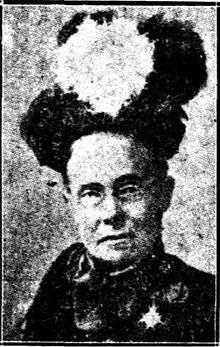Mary Harriett Griffith
Mary Harriett Griffith (1849–1930) was a philanthropist in Brisbane, Queensland, Australia. She was prominent in organisations promoting Christianity and the interests of women and children.[1]
Early life

Mary Harriet Griffith was born 4 November 1849 Portishead, Somerset, England, the daughter of Rev. Edward Griffith and Mary, née Walker.[1] She was only four years old when the family came out to Australia in the small sailing ship Nile. The voyage from Sydney to Brisbane was made on the little coaster steamer, City of Melbourne.[2] Her brother was Samuel Griffith (later Premier of Queensland).
Her father Rev. Edward Griffith was one of the pioneers of Congregationalism in Queensland. The family settled in Ipswich, Queensland. After a few years there Mr. Griffith took the oversight of the Congregational church at Maitland, New South Wales. His sons attended the high school there, and Miss Griffith also received portion of her schooling at that town. In 1860, her father relocated to Brisbane where he was the minister at the Wharf Street Congregational Church.[1]
Religious and charitable work
Miss Griffith found a congenial atmosphere in the church work into which she entered with a quiet zeal which characterised all of her life. She never sought pre-eminence, but her work was marked by practicality and an absence of ostentation. The spectacular did not appeal to her. Her judgment was sound, while she was not at all obstinate. Her opinions once formed, took some convincing to remove. Her entire absence of pride appealed to all who came into contact with her. She was essentially Victorian in her outlook on life, and religiously her sympathies extended beyond those of her own denomination, and showed the breadth of her view of life. Many public institutions benefited by her wise counsel and practical help, including the Lady Musgrave Lodge, the Children's Hospital, the Charity Organisation Society, the National Council of Women, the City Mission, the Brisbane Benevolent Society, the Women's Christian Temperance Union, the Young Women's Christian Association and the Aged Christian Women's Home.[3]
During World War I, Miss Griffith was associated with the Red Cross Society and other, patriotic organisations. In 1911 she was honoured with the distinction of Lady of Grace of the Order of St. John of Jerusalem, of which she was the only recipient in Queensland. The decoration was conferred upon her at Government House by Sir J William MacGregor, the then Governor of Queensland.[3]
Later life
She died on 27 July 1930 aged 80 at the Aged Christian Women's Home New Farm, Brisbane and buried with Congregational forms in Toowong cemetery.[4]
The main entrance doors to the Young Women's Christian Association rooms were officially opened, and dedicated in her memory on 6 May 1931. The doors are of glass, ornamented with the association triangle in royal blue, black, and gold. Lady Goodwin, who officially unlocked the doors, was met on arrival by the president (Mrs. W. H. Birnes) and the general secretary (Miss Rose Winter). She was presented with a sheaf of gladioli. In unveiling the table above the doors Lady Goodwin paid tribute to the long and unselfish life of Miss Griffith. Mrs. Barnes expressed the boards desire to pay tribute to Miss Griffith, who had given a great deal of her life to the Young Women's Christian Association.[4]
Publications
- Griffith, Mary Harriet; Griffith, Edward, 1819–1892 (1892). Memorials of the Rev. Edward Griffith. R.S. Hews & Co. Retrieved 6 March 2017.CS1 maint: multiple names: authors list (link)
References
- Gillespie, Aline (2005). "Griffith, Mary Harriett (1849–1930)". Australian Dictionary of Biography. Retrieved 3 March 2017.
- "Miss M. H. Griffith, L.G." The Telegraph (17, 191) (SECOND ed.). Brisbane. 7 January 1928. p. 11. Retrieved 6 March 2017 – via National Library of Australia.
- "MISS GRIFFITH". The Week. CIX (2, 849). Brisbane. 1 August 1930. p. 17. Retrieved 6 March 2017 – via National Library of Australia.
- "Woman's Page". The Daily Standard (5712). Brisbane. 7 May 1931. p. 11. Retrieved 6 March 2017 – via National Library of Australia.
External links
- Griffith, Mary Harriet in The Encyclopedia of Women and Leadership in Twentieth-Century Australia
![]()